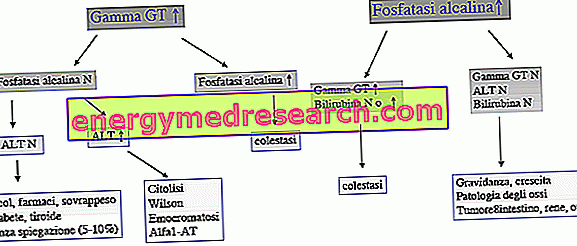Generality
Gamma Glutamil Transferase (GGT or gamma GT) is an enzyme found in various body tissues. This protein is found mainly at the hepatobiliary level, but it can also be present in the heart, kidneys and pancreas. Its main function is to transport amino acids across cell membranes.

The values found are often compared with those of alkaline phosphatase .
What's this
Gamma glutamyl transferase (GGT or gamma GT) is an enzyme involved in the transfer of the gamma-glutamyl group from one peptide to another; it is important in the transfer of amino acids through the plasma membrane, in the metabolism of leukotrienes and in that of glutathione.
Why do you measure
The dosage of the GT range is used in the screening and treatment of diseases of the liver and biliary tract, such as cirrhosis, cholestasis and primary and secondary liver tumors.
Although the Gamma glutamyl transferase can be found in the cell membranes of many tissues - including kidney, pancreas, spleen, heart, brain and sminal vesicles - its serum concentrations seem to depend mainly on the health of the hepatobiliary system. For this reason, high levels of GGT in the blood are commonly found in all diseases of the liver and biliary tract.
However, the clinical significance of serum Gamma Glutamyl Transferase is diminished by low specificity; a particularly high value of the GT range indicates the probable presence of liver damage, but does not give any information on its origin. Therefore, the plasma dosage of this enzyme provides very little additional information compared to those deriving from the determination of transaminases, alkaline phosphatase and bilirubin.
The simultaneous dosage of glutamyl transferase and alkaline phosphatase (ALP), tells us if the increase of the latter is of hepatic origin (both values are increased) or if it is due to a problem of the bone tissue (only the phosphatase increases alkaline).
When is it prescribed?
The GGT evaluation is indicated by the doctor for:
- Define a possible pathology of the liver or biliary tract;
- Distinguish liver disease from bone, as a cause of increased alkaline phosphatase (ALP).
The GT range test can be prescribed together with other tests or as a follow-up to other liver function tests, when the patient has signs and symptoms of liver damage, such as:
- Weakness and fatigue;
- Loss of appetite;
- Nausea, vomiting;
- Swelling and / or abdominal pain;
- Jaundice;
- Dark urine and light stools.
Sometimes, the Gamma Glutamil Transferase test can be used for screening and monitoring of acute or chronic alcohol abuse .
Normal values
REFERENCE VALUES GLUTAMYL TRANSFERASE RANGE, CAUCASIAN RACE (laboratory-to-laboratory variables)
- MAN: 55 U / L
- WOMAN: 38 U / L
Fasting is normally required for 8-12 hours prior to collection.
GGT Alta - Causes
Gamma Glutamil Transferase is increased in most diseases that cause damage to the liver or biliary tract .
Usually, GGT is the first liver enzyme that increases in the blood when one of the ducts carrying bile from the liver to the intestine becomes blocked (for example, due to a tumor or a calculus). For this reason, the GT range is the most sensitive liver enzyme in determining bile duct problems.
However, Gamma Glutamil Transferase is non-specific and not very useful when it is necessary to differentiate the various causes of damage to the liver (eg tumor or hepatitis) or other extra-hepatic diseases (such as acute coronary syndrome).
When compared to the increase in alkaline phosphatase (ALP), GGT can provide useful indications to make the diagnosis. Both of these enzymes increase in liver disease, but ALP is also increased in bone diseases. In practice, the GT range makes it possible to distinguish whether this result is attributable to the liver or bones.
High values of Gamma Glutamil Transferase may be an indicator of:
- Hepatic disorders (hepatitis of viral origin, cirrhosis, tumors or therapy with toxic drugs for the liver);
- Alcoholism;
- Cardiovascular disease, congestive heart failure and / or hypertension;
- Diabetes;
- pancreatitis;
- Kidney diseases;
- Hyperthyroidism;
- Pregnancy;
- Tobacco addiction.
The drugs that can cause an increase in GGT are phenytoin, carbamazepine and barbiturates, such as phenobarbital.
Also the use of other medicines that need or not have a medical prescription can increase GGT. These include: non-steroidal anti-inflammatory drugs (NSAIDs), statins, antibiotics, histamine receptor blockers (used to treat excessive production of stomach acid) and antidepressants.
High GGT and alcoholism
A high gamma-GT represents a particularly sensitive index of alcoholism.
In alcoholics, serum GGT increases by a mechanism of enzyme induction, therefore independently from the presence or not of alcohol-related liver damage (if present, however, the increase in gamma-GT is more consistent).
The increase in GGT is therefore typically associated with excessive alcohol consumption, especially when blood tests show a disproportionate increase compared to the rise in other markers of liver function (ALP or ALT).
In alcoholics, gamma-GT levels return to normal no earlier than 3-4 weeks after alcohol withdrawal; this test is therefore particularly useful for following alcoholic detoxification programs over time. See also: tests for the diagnosis of alcoholism.
GGT Low - Causes
When low GT values emerge from the analyzes, there is absolutely nothing to worry about. In fact, reduced levels of this enzyme indicate nothing but good functioning of our liver.
In addition, normal or low GGT concentrations indicate that it is unlikely that the patient has liver disease or has consumed alcohol.
Clofibrates (used in hyperlipidemias) and oral contraceptives may decrease the gamma GT concentration.
How to measure it
The examination of the Gamma Glutamil Transferase is performed with a normal collection of peripheral blood from the vein of an arm.
Preparation
GGT concentrations decrease after eating. Therefore, it is possible that the patient is required to eat nothing for 8-10 hours prior to the test. Furthermore, he is also likely to be asked to stop drinking alcohol or taking certain drugs. During this period, it is only possible to take a small amount of water.
Interpretation of Results
| DETECTED CELL PHONE | |||
| ACUTE | CHRONIC | CHOLESTASIS | |
| Albumin | normal or diminished | normal or severely diminished | normal |
| Bilirubin | normal or strongly increased | normal or increased | increased |
| transaminases | strongly increased | increased | slightly increased |
| ALP | normal | normal | strongly increased |
| GGT | slightly increased | slightly increased | strongly increased |
| PT (prothrombin time) | normal | slightly increased | slightly increased |

The activity of gamma-GT and its blood concentrations also increase in people taking active drugs on cytochrome P450 (barbiturates, antiepileptics, anticoagulants, NSAIDs).
| Gamma glutamyl transferase HIGH | LOW-GT RANGE | ||
| Intrahepatic causes | Extrahepatic causes | Intrahepatic causes | Extrahepatic causes |
| All cases of intrahepatic cholestasis, such as cirrhosis, hepatitis, primary and secondary liver tumors, amyloidosis, sarcoidosis, tuberculosis | All cases of extrahepatic cholestasis, such as pancreatitis and bile duct diseases | Congenital deficiencies | Hemolysis |
| Doubles in African Americans | After lunch | ||
| > 25% if high BMI; > 50% if BMI> 30. | Pregnancy (decreased by 25% in the first period) | ||
| Smoke (> 10% if 20 cigarettes a day; doubles for greater consumption) | |||
| Alcohol consumption | |||
| Drugs (carbamazepine, phenobarbital, phenytoin, valproic acid, cimetidine, furosemide, heparin, oral contraceptives) | |||
| Hepatic ischemia | congestive heart failure | ||
| Liver steatosis | Pancreatitis, pancreatic tumors | ||



